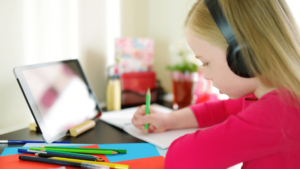Sitting on the sofa in your pajamas and staring at the monitor for several hours is not the typical student-classroom experience. But in light of the pandemic, distance learning has become part of our new normal.
More than a year since the start of the pandemic, most countries around the world have employed isolation and containment protocols to minimize the spread of disease. One of these protocols includes closure of educational institutions, from the kindergarten level up to the universities. As a result, education has changed drastically, with the transition from traditional school-based learning to e-learning.
The sudden, unplanned, and unforeseen changes have been very challenging to students, teachers, and even parents, who now have to adapt to new teaching and learning methods. There was no ample transition period to properly give everyone time to adjust. Globally, over 1.2 billion children affected by school closures are out of the classroom and conducting their classes in the comforts of their homes or apartments. With the ongoing pandemic, this number is expected to rise further in the next few months.

What is Distance Learning?
The usual mode of teaching pre-pandemic was through traditional learning. Traditional learning takes place in a classroom setting, where there is a teacher and students who get to interact and learn together every day. In face-to-face scenarios, regular attendance is required, with a fixed schedule, and the interaction is a source of knowledge.
In contrast, distance learning is done mostly through online platforms with minimal face-to-face interactions. A research done on barriers to learning during the COVID 19 outbreak stated that distance learning is a platform that many schools use to meet the learning needs of students. It has also been determined that distance learning is an effective approach at the college, university, and high school level parents’ perspective. Since students are required to stay home, teaching is now undertaken mostly on digital platforms such as Google Classroom and Zoom.
The Challenges of Distance Learning
Distance learning offers the advantages of providing flexibility of time and place, there are challenges associated with it.
One problem is logistics and technical barriers to distance learning. One survey done by OECD revealed that 95% of students in several European countries such as Switzerland, Norway, and Austria have a personal computer to use for their school. In contrast, in some countries such as Indonesia, only 35% of students do. Another important issue is reliable internet access – which is not available especially in children living in remote areas.
Mental Health Challenges With Distance Learning
A mentally healthy person will normally be able to cope with the normal stresses of life and school, however, the concept of distance learning presents a new level of stress among students.
Aside from technical and logistics barriers to distance learning, there are also mental health challenges experienced with distance learning. According to the Centers for Disease Control and Prevention, a surge was seen in the number of visits to the emergency department. Around 24-31% increase in consults for mental health was seen among children and adolescents.
Lack of social interactions
Social relationships can affect mental health. Distance learning has taken away face-to-face interactions between students and teachers. A lack of social interaction with peers can lead to feelings of isolation and helplessness. The minimized interaction between teacher and student can lead to ineffective teaching and learning.
Distance learning has been studied to precipitate mental health issues including depression, anxiety, schizophrenia, insomnia, and dementia. At least 18% of students reported having depressive episodes and anxiety attacks during distance learning. Not having enough personal interaction can trigger and harbor feelings of sadness and helplessness.
Reduced motivation to learn
Distance learning has taken away the regular schedule and daily routine that students have during face-to-face interactions. A daily routine promotes good mental health as people know what to expect of their day and minimal disruptions are experienced. Distance learning has resulted in a lack of structure in our lives, leading to anxiety and stress due to uncertainty of events.
The pandemic has disrupted many students’ daily routines, resulting in a lack of structure that can contribute to stress, anxiety and even clinical depression. Since there is no clear routine to follow for these students, they are generally less motivated to learn.
Physical and mental exhaustion
Many students in distance learning would say they feel more exhausted from looking at the screens all day. Some students have reported getting headaches and back pains due to poor posture during classes and no proper armchair or table to work with.
More than physical exhaustion, students also experience mental exhaustion. Distance learning works on a faster pace than traditional learning, and the questions of students are not as easily addressed. Mental fatigue may be experienced during prolonged online lectures.

Parting Words
It is now obvious that the COVID 19 pandemic is taking a toll on many aspects of our lives, and for students, it has taken a toll on their learning. While distance learning minimizes the spread of the virus, it has also presented new challenges on mental health of students.
If you are a teacher, parent, or student finding it difficult to cope with the dramatic changes of distance learning, we are more than happy to help you cope. Our experts at MindShift Psychological Services are trained to help people deal with mental issues and challenges.
Contact the nearest MindShift Wellness Center near me and learn how to handle distance learning. We offer Individual Psychotherapy and Therapy for Children to help you deal with the challenges of distance learning.



